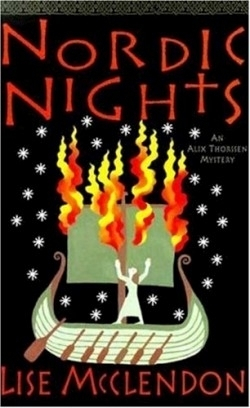
Nordic Nights
An Alix Thorssen Mystery
The third Alix Thorssen mystery novel is set in Jackson Hole, Wyoming, during the town’s annual winter festival. Forget about cowboys and gunfights. This Jackson Hole is a tourist town with artsy shops, skiers in Lycra tights, press conferences at the chamber of commerce office and ice sculptures in the town square.
Alix, owner of an art gallery, has just installed in her showroom a celebrated Norwegian artist and his huge murals depicting Norse myths. She half-heartedly tries to meet her obligations as a festival volunteer. With her boyfriend tucked away in an Arizona desert learning to fly helicopters, she is free to suffer the sexual advances of a Lycra-clad professional skier.
Then the great mural artist is murdered, and it is Alix’s own stepfather, Hank Helgeson, caught standing over the body. Hank won’t say a word in his own defense. With a subplot about strained family relationships percolating in the background, Alix is pulled deeper and deeper into a case involving a malevolent fortune teller named Madame Isa, magical rune stones and passions over who first arrived at the New World, Columbus or the Vikings.
Things go from bad to worse. Someone torches the float Hank built for the festival parade. Someone runs down Alix’s mom, putting her in the hospital. Shots are fired through the gallery window. Alix’s friend, Luca, tells her she has seen the pattern before, in her native Argentina. “This is how it begins there,” Luca says. “Little things. “ The intimidation of a family. Someone is arrested. Something they love is burned or destroyed. They are hurt but not so badly
they die. They have pain.”
Alix has a high tolerance for pain. She doesn’t so much drive the plot as survive it: a trailer hitch falls on her, her hands are burned putting out the burning parade float, she nearly drowns beneath a frozen river. Plus, she must bear the sting of seeing her skier, who has nearly succeeded in seducing her, kissing the mysterious Madame Isa.
This is festival time, however, and such events are matched with more pedestrian moments such as running into Harrison Ford at a bar, eating Luca’s black beans spiced with chilies and cinnamon and speculating about the intentions of the gruff ice sculptor whose work, towering in the town square, looks suspiciously phallic. Such moments, in fact, soften the effect of a rather implausible plot and anchor the story in a reality recognizable to readers who have spent a little time in a small town during an annual festival.
The ending, in which not quite all is revealed and not all loose ends are neatly tied up, has the same satisfying reality about it—rather like the slight drabness of the streets in the Monday morning sun when the festival is over. (December, 1999)
Reviewed by
Rich Wertz
Disclosure: This article is not an endorsement, but a review. The publisher of this book provided free copies of the book to have their book reviewed by a professional reviewer. No fee was paid by the publisher for this review. Foreword Reviews only recommends books that we love. Foreword Magazine, Inc. is disclosing this in accordance with the Federal Trade Commission’s 16 CFR, Part 255.
